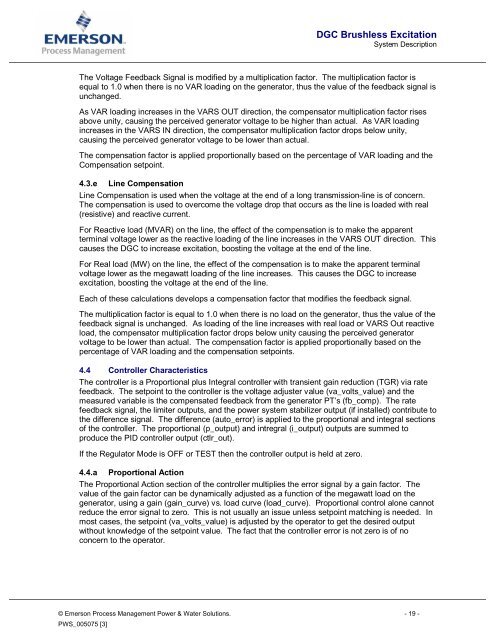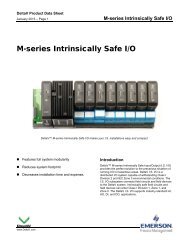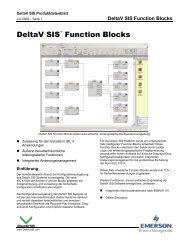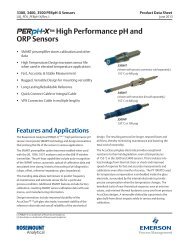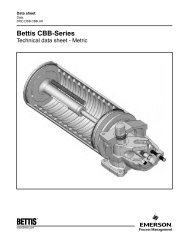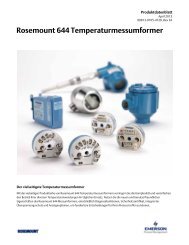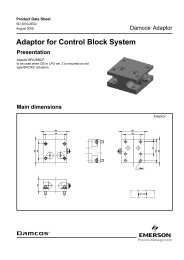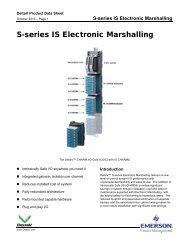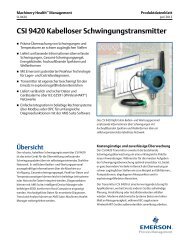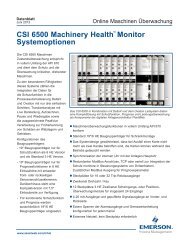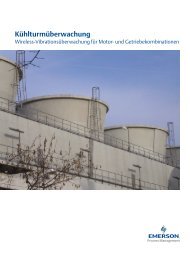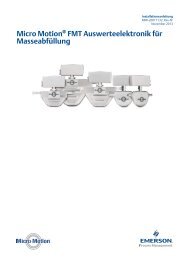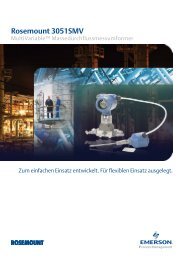DGC Brushless Excitation - Emerson Process Management
DGC Brushless Excitation - Emerson Process Management
DGC Brushless Excitation - Emerson Process Management
Create successful ePaper yourself
Turn your PDF publications into a flip-book with our unique Google optimized e-Paper software.
<strong>DGC</strong> <strong>Brushless</strong> <strong>Excitation</strong><br />
System Description<br />
The Voltage Feedback Signal is modified by a multiplication factor. The multiplication factor is<br />
equal to 1.0 when there is no VAR loading on the generator, thus the value of the feedback signal is<br />
unchanged.<br />
As VAR loading increases in the VARS OUT direction, the compensator multiplication factor rises<br />
above unity, causing the perceived generator voltage to be higher than actual. As VAR loading<br />
increases in the VARS IN direction, the compensator multiplication factor drops below unity,<br />
causing the perceived generator voltage to be lower than actual.<br />
The compensation factor is applied proportionally based on the percentage of VAR loading and the<br />
Compensation setpoint.<br />
4.3.e Line Compensation<br />
Line Compensation is used when the voltage at the end of a long transmission-line is of concern.<br />
The compensation is used to overcome the voltage drop that occurs as the line is loaded with real<br />
(resistive) and reactive current.<br />
For Reactive load (MVAR) on the line, the effect of the compensation is to make the apparent<br />
terminal voltage lower as the reactive loading of the line increases in the VARS OUT direction. This<br />
causes the <strong>DGC</strong> to increase excitation, boosting the voltage at the end of the line.<br />
For Real load (MW) on the line, the effect of the compensation is to make the apparent terminal<br />
voltage lower as the megawatt loading of the line increases. This causes the <strong>DGC</strong> to increase<br />
excitation, boosting the voltage at the end of the line.<br />
Each of these calculations develops a compensation factor that modifies the feedback signal.<br />
The multiplication factor is equal to 1.0 when there is no load on the generator, thus the value of the<br />
feedback signal is unchanged. As loading of the line increases with real load or VARS Out reactive<br />
load, the compensator multiplication factor drops below unity causing the perceived generator<br />
voltage to be lower than actual. The compensation factor is applied proportionally based on the<br />
percentage of VAR loading and the compensation setpoints.<br />
4.4 Controller Characteristics<br />
The controller is a Proportional plus Integral controller with transient gain reduction (TGR) via rate<br />
feedback. The setpoint to the controller is the voltage adjuster value (va_volts_value) and the<br />
measured variable is the compensated feedback from the generator PT’s (fb_comp). The rate<br />
feedback signal, the limiter outputs, and the power system stabilizer output (if installed) contribute to<br />
the difference signal. The difference (auto_error) is applied to the proportional and integral sections<br />
of the controller. The proportional (p_output) and intregral (i_output) outputs are summed to<br />
produce the PID controller output (ctlr_out).<br />
If the Regulator Mode is OFF or TEST then the controller output is held at zero.<br />
4.4.a Proportional Action<br />
The Proportional Action section of the controller multiplies the error signal by a gain factor. The<br />
value of the gain factor can be dynamically adjusted as a function of the megawatt load on the<br />
generator, using a gain (gain_curve) vs. load curve (load_curve). Proportional control alone cannot<br />
reduce the error signal to zero. This is not usually an issue unless setpoint matching is needed. In<br />
most cases, the setpoint (va_volts_value) is adjusted by the operator to get the desired output<br />
without knowledge of the setpoint value. The fact that the controller error is not zero is of no<br />
concern to the operator.<br />
© <strong>Emerson</strong> <strong>Process</strong> <strong>Management</strong> Power & Water Solutions. - 19 -<br />
PWS_005075 [3]


